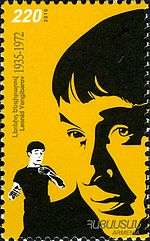Leonid Yengibarov
| Leonid Yengibarov | |
|---|---|
|
Statue of Leonid Yengibaryan in Tsakhkadzor | |
| Born |
March 15, 1935 Moscow |
| Died |
July 25, 1972 (aged 37) Moscow |
| Cause of death | infarction |
| Nationality | Armenian |
| Occupation | clown and actor |
| Partner(s) | Jarmila Galamkova |
| Children | Barbara Yengibarova (Born in 1965) |

Leonid Georgievich Yengibarov (Armenian: Լեոնիդ Ենգիբարյան; Russian: Леонид Георгиевич Енгибаров; March 15, 1935 – July 25, 1972) was a Soviet clown and actor.
Biography
Leonid Yengibarov was born in Moscow to an Armenian father and a Russian mother. He started his career as a boxer. In 1955 he joined the State School of Circus Art, Clownship department. He graduated from Circus school with skills in juggling, acrobatics, and hand balancing. After graduation in 1959 he moved to Yerevan and joined the Armenian state circus.[1]
He was one of the first Soviet clowns to create the poetic, intellectual clownery, which made spectators think, not only laugh. Leonid Yengibarov, 'the clown with sad eyes', revolutionized the art of clownery by introducing lyrical tones into traditional buffoonery and grotesque sequences.[2] According to the Spectacle journal,
"he has shown the direction. He was the innovator. He began to do clown gags that were not funny, but very sad. They ended sadly. He felt that life was not funny anymore".[3]
After initial incomprehension, his popularity grew immensely. After that he was invited to work in cinema. His first film, A Path to the Arena, was in fact about himself.
By the end of the 1960s he was known as one of the best clowns in the country and in the countries of the Eastern bloc, where he was permitted to travel. His circus career came to a halt in 1971: he left the State Circus when his partner was banned from international touring. He created a Variety Pantomime Theatre (Estradniy teatr pantomimi) instead.[4] However officially he was forbidden to call his company “theatre”, only allowed to use the term “troupe” (ансамбль). He managed to stage only a single piece, “Star Rain” before his untimely death from a massive heart attack.
His work continues influencing other artists including Slava Polunin.[5]
His friend Vladimir Vysotsky wrote a shrill poem "To memory of the actor; To Yengibarov from the audience". Alla Pugacheva dedicated her song "Arlekino" to Yengibarov: "He was my favourite clown and even died while working. Just think: he died from laughter".[6]
Filmography
- 1963: A Path to the Arena, Путь на арену
- 1964: Shadows of Forgotten Ancestors, Тени забытых предков (directed by Sergei Parajanov)
- 1966: Aybolit-66, Айболит-66
- 1971: A Necklace for My Beloved, Ожерелье для моей любимой. (Comedy, directed by Tengiz Abuladze, cast in the Georgian SSR, Soviet Union)
- 1972: Stoves-Benches, Печки-лавочки
Films about him
- Please meet Leonid Yengibarov, Знакомьтесь: Леонид Енгибаров
- 2 Leonid 2, 2 Леонид 2
Honors
- The E. Bass Cup (first prize) of the 1964 European Clown Competition in Prague;
- People's Artist of Armenia (1971).
References
- ↑ Historical Dictionary of Russian Theater - Page 111, by Laurence Senelick - 2007
- ↑ Encyclopedia of Contemporary Russian Culture - Page 446, by Smorodinskaya, - 2013
- ↑ Spectacle: A Quarterly Journal of the Circus Arts - Volume 2 - Page 8, 1998
- ↑ Historical Dictionary of Russian Theater, by Laurence Senelick, Scarecrow Press, 2007, p. 112
- ↑ "Return to childhood with Slava's Snow Show at Southbank Centre". The Independent. Retrieved 2016-03-28.
- ↑ Red Stars: Personality and the Soviet Popular Song, 1955-1991, by David MacFadyen - 2001, p. 216